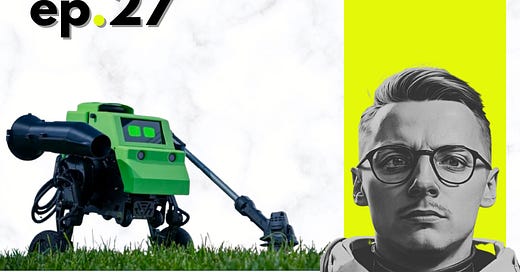EP.27 ROBOT THAT WILL TAKE CARE OF YOUR GARDEN
Figure got a funding, a robot for your garden, robots in confined spaces & much more ...
This robot will take care of your yard! 🌱
Electric Sheep Robotics, based in San Francisco, is introducing a fun and efficient AI-powered robot called Verdie for outdoor maintenance. Verdie is designed to trim edges, blow debris, and handle power tools with ease.
This robot is part of Electric Sheep's initiative to revolutionize outdoor maintenance with emission-free technology. They aim to replace pollutant gas-powered tools while addressing labor shortages in the industry. Verdie is powered by a generative AI model named ES1, which learns from simulated and real-world outdoor scenarios to navigate obstacles and perform tasks efficiently.
Equipped with stereo cameras and an articulated wheeled platform, Verdie can adapt to various outdoor environments. Electric Sheep plans to deploy Verdie starting from Q2 2024, making outdoor maintenance more autonomous and eco-friendly.
Human-speed manipulation achieved! 🎯
Sanctuary AI's Phoenix humanoid robot is making waves in the robotics world with its impressive speed and natural movements. Unlike other humanoid robots, Phoenix boasts "the world's best robot hands," which are hydraulically actuated for precision, speed, and strength.
Sanctuary AI takes a unique approach to teaching Phoenix tasks, focusing on fundamental movements similar to a baby playing with toys. By concentrating on these basics, Phoenix is expected to accelerate its capabilities rapidly. Despite not yet walking, Phoenix's finely-tuned hands allow it to perform tasks autonomously with remarkable fluidity and efficiency.
Sanctuary AI's co-founder Suzanne Gildert proudly claims that Phoenix's hands are the pinnacle of robotic design, capable of mimicking all 33 primary human hand motions. As Phoenix continues to evolve, its groundbreaking advancements in robotics promise a future where robots seamlessly integrate into various aspects of our lives.
Meme of the week 🤖
Build a cobot with MATLAB! 🤖
The course explores the development of a collaborative robot system to meet customer needs through a human-robot coworking environment, emphasizing multimodal control and adaptive dynamic control techniques.
Introduction to the need for flexible robotics systems in satisfying diverse customer demands.
Development of a robot hand incorporating multiple sensors using Model-Based Design with MATLAB® and Simulink®.
Integration of virtual and real control structures for seamless implementation.
Demonstration of robot arm modeling, trajectory planning, and simulation using Robotics System Toolbox™ and ROS Toolbox.
A huge $675 million funding for Figure! 🤖
A company called Figure, which makes humanoid robots, has just raised a huge amount of money—$675 million—to reach a valuation of $2.6 billion. Big-name investors like Microsoft, OpenAI, and Amazon are backing them.
Figure's goal is to create robots that can do various tasks in industries like warehouses, where repetitive work is common. They've already made progress, and their robots can understand and respond to human language better. This funding will help Figure bring its robots to the market faster.
The robots are slow and careful in their movements, but they're getting better. Microsoft is helping them with technology, and they've even partnered with BMW. Overall, Figure's success shows the growing interest and investment in robots that can work alongside humans.
Robots walking in confined spaces! 🪨
This research paper introduces a method to make legged robots more capable of moving through complex environments that are difficult for traditional robots to navigate. Legged robots can carefully choose where to place their feet and adjust their body position while walking, making them potentially useful in places that are hard to reach.
However, using legged robots in real-world situations is still tricky. In this paper, the researchers propose a solution using a combination of reinforcement learning (a type of machine learning) and 3D representations of the environment.
The method involves two layers of control: a lower-level policy that helps the robot follow commands precisely in six dimensions (like moving forward, backward, up, down, and turning), and a higher-level policy that helps the robot understand its surroundings in three dimensions (like being aware of obstacles above it). Their results showed that their approach works well, allowing the robot to navigate effectively in challenging environments.
Keep reading with a 7-day free trial
Subscribe to we all are robots to keep reading this post and get 7 days of free access to the full post archives.







